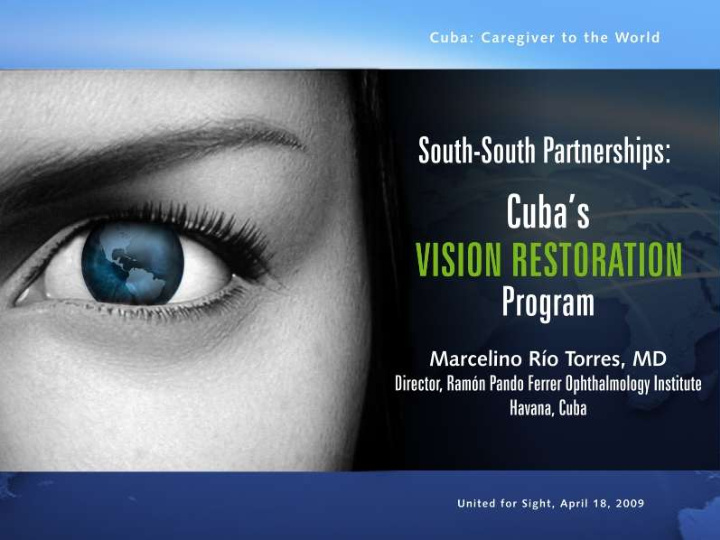



Republic of Cuba 114 000 km2 11.2 million pop. 14 Provinces / 1 Special Municipality Cuban Health System Universal, geographically accessible Without distinction (by race, gender, creed or politics) Community-based Intersectoral Principle of international coopperation
Health in Cuba: Evolution 1959 2007 6,286 doctors, most in private 72,416 doctors, 44.9% family practice in major cities; 50% doctors. 99.7% of rural areas emigrated after the revolution . covered. Infant mortality >60 x 1000 live Infant mortality 5.3 x 1000 live births births Life Expectancy <60 years Life Expectancy: 77 years High prevalence of infectious Chronic noncommunicable diseases. diseases prevail. Immunization program against 13 diseases One medical school 24 medical schools
Human Resources MD’s Ophthalmologists 1959 6,000 118 1963 3,000 38 2007 72,400 940 In 2009: 950 ophthalmologists 1,600 residents in ophthalmology
International Medical Cooperation: Disaster Relief 1960: First Cuban medical assistance Emergency medical team and 8 tons of medical equipment and supplies to earthquake-stricken Chile.
International Medical Cooperation: Long-Term Assistance 1963: first year of long-term international medical cooperation program. Cuban medical team serves one year in recently independent Algeria (57 doctors, nurses, and technicians, including 2 ophthalmologists).
Cuban Health Professionals Abroad 1963-2008: 127,600 health professionals in 104 countries (includes those who have served more than once) Currently: 38,538 Cuban health professionals in 74 countries (mainly in poor and remote regions, primary care)
Training International Human Resources for Health • Medical schools abroad: Cuba has founded 11 medical schools in developing countries • Latin American Medical School, Havana: Graduated 5,960 low-income students from the Americas and Africa since 2005. Current enrollment: 9,466
Cuba’s Vision Restoration Program: Operation “Miracle” • Eye care for those in need • Development of human resources • Development of technological infrastructure
The Beginnings 2004 Cuban teachers in Venezuela’s literacy program discovered vision problems among their students. The vision restoration program began as a bilateral effort to solve this problem.
2005 and Beyond 2005 Patients from Cuba, 15 Caribbean and 12 Latin American countries were added to in the program. TODAY Patients from 34 countries…
Patients’ Countries of Origin Caribbean Central & South America Africa Antigua & Barbuda Argentina Angola Bahamas Belize Mali Barbados Bolivia Cuba Brazil Dominica Colombia Grenada Ecuador Haiti El Salvador Jamaica Guatemala Martinique Guyana Montserrat Honduras St. Kitts & Nevis Mexico St. Lucia Nicaragua St. Vincent & the Grenadines Panama Suriname Paraguay Trinidad & Tobago Peru Uruguay Venezuela
The Cuban Eyecare and Prevention Program 24 Eyecare Centers
Geographic Distribution of Eyecare Centers CUBA-VENEZUELA-BOLIVIA-BRAZIL- NICARAGUA-ECUADOR-GUATEMALA HONDURAS-MEXICO-PANAMA-PARAGUAY- PERU-URUGUAY-MALI-ANGOLA 59 Centers in 15 countries, with 87 surgical stations
Surgical Interventions 2004-present: 1,562,608 patients surgically treated Of these: 360,826 cataracts (23%). Cubans were 112,698 14,173 glaucomas 45,942 laser treatments Conditions treated: Cataracts, Pterigium, Eyelid Ptosis, Squint, Glaucoma, Diabetic retinopathy
Results 2004-2009 Vision has been restored or improved in 1,562,608 patients
Thank You
Recommend
More recommend